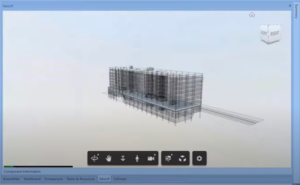The Impact of BIM Modeling Services on Building Lifecycle
By Adil Husnain - TechBullion
Welcome to our in-depth exploration of Building Information Modeling (BIM) services. In today's construction industry, BIM is a game-changer transforming how we plan, design, construct, and manage buildings. It goes beyond merely creating a detailed 3D model; it offers an intelligent information model that spans the entire lifecycle of a building. Join us as we delve into the fascinating world of BIM and its profound impact on the industry.
This article explores the significant impact of BIM on that lifecycle, from inception to demolition, demonstrating why the construction industry is embracing this technology at an accelerated pace. Whether you're a seasoned industry professional or a curious newcomer, this piece will offer valuable insights into BIM modeling services' transformative power.
Design Phase
A. Improved Communication and Collaboration
BIM is an instrumental tool that fosters effective communication and collaboration among all stakeholders. The building is meticulously designed, with every aspect, from structure to systems, seamlessly integrated into a unified model. This centralized approach facilitates easy access to information for architects, engineers, and other stakeholders, fostering effective collaboration and ensuring a shared understanding of the project. By eliminating information silos, BIM facilitates the seamless exchange of ideas, leading to smoother design processes and enhanced project outcomes.
B. Reduced Errors and Clashes:
One of the standout features of BIM is its clash detection capabilities. During the design phase, BIM can help identify and resolve potential conflicts between different building systems, such as structural elements clashing with HVAC systems. This early conflict resolution reduces errors and avoids costly rework during the construction phase. With BIM, we can anticipate and address these issues well in advance, contributing to a more efficient and cost-effective project.
C. Enhanced Visualization and Decision-Making
The power of BIM's 3D modeling goes beyond aesthetics. It allows stakeholders to visualize their building in a way that 2D drawings cannot. This detailed and realistic view of the building enables stakeholders to make informed decisions, from choosing materials to finalizing design elements. Moreover, the ability to iterate and see the changes in real-time streamlines the design process, reducing time spent on revisions and accelerating the project timeline.
Construction Phase
A. Improved Planning and Scheduling:
BIM takes project management to new heights in construction by enhancing planning and scheduling capabilities. By providing a detailed and intuitive 3D model of the building, BIM allows project managers to schedule tasks more accurately, track progress in real-time, and foresee potential delays. This results in a streamlined construction process with improved time efficiency. The integrated nature of BIM also enables stakeholders to coordinate and align their tasks effectively, ensuring smooth transitions between different phases of the project.
B. Reduced Waste and Rework:
BIM also plays a pivotal role in promoting sustainable construction practices. It minimizes waste and optimizes resource utilization by giving a precise estimate of the required materials. Additionally, BIM's early clash detection capabilities prevent on-site clashes and rework, leading to significant cost savings. As a result, projects leveraging BIM align with environmental sustainability goals and witness a dramatic increase in cost-effectiveness.
C. Increased Safety:
Worker safety is a paramount concern in the construction industry, and BIM is a powerful tool to enhance it. BIM simulates the construction process in a virtual environment and identifies potential safety hazards, such as falls or clashes with moving equipment. This allows project managers to deploy preemptive measures, train workers accordingly, and adjust project plans to mitigate risks. Thus, BIM contributes to an overall safer construction environment, minimizing accidents and fostering a culture of safety awareness.
Operation and Maintenance Phase
A. Enhanced Asset Managment:
BIM thrives as a digital repository of comprehensive building information, becoming an invaluable resource for facility managers. Within the BIM model, every building detail, from major systems down to individual components, is meticulously documented. This centralized information hub facilitates asset tracking, ensuring equipment is properly maintained and replaced when necessary. Consequently, facility managers can plan preventative maintenance more effectively, reducing disruptions and promoting smoother facility management operations.
B. Improved Energy Efficiency:
BIM also exhibits an impressive capability for energy analysis and simulation. It can model energy consumption patterns and identify areas where energy usage can be minimized. By simulating various scenarios, BIM aids in understanding the energy impact of different design choices and operational strategies. Consequently, it encourages environmentally friendly practices by highlighting energy-saving opportunities, thus playing a pivotal role in promoting sustainable building operations.
C. Reduced Lifecycle Costs:
BIM's wealth of data underpins informed decision-making that optimizes building maintenance and lifecycle costs. By providing a holistic view of the building's lifecycle, BIM allows building owners to make data-driven decisions, from routine maintenance to significant renovations. These informed decisions result in efficient use of resources and extended asset lifespan, gradually reducing operating costs. Through such optimizations, BIM ultimately yields substantial financial benefits for building owners over the long term, validating its position as a powerful tool in building management.
Conclusion
In conclusion, implementing Building Information Modeling (BIM) significantly enhances the entire building lifecycle. It not only boosts efficiency and reduces costs but also paves the way for superior outcomes. Moving forward, advancements in BIM technology promise to shape the construction industry's future, fostering even greater innovation and growth.
This article was written by Adil Husnain from TechBullion and was legally licensed through the DiveMarketplace by Industry Dive. Please direct all licensing questions to legal@industrydive.com.

-1.png?width=112&height=112&name=image%20(4)-1.png)














